Automata 101: The Artist as Golem Maker – Part Two
Rhonda Knight is an Associate Professor of English at Coker College in Hartsville, SC. She teaches Medieval and Renaissance literature as well as composition courses. This blog will outline her experiences teaching an Honors English Composition course about created entities, beginning with the golem of Jewish legend and continuing through cyborgs, robots, androids, and artificial intelligence.
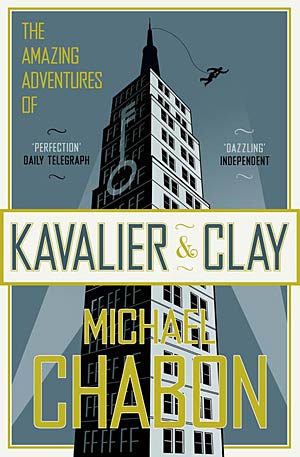 “They’re all Jewish, superheroes. Superman, you don’t think he’s Jewish? Coming over from the old country, changing his name like that. Clark Kent, only a Jew would pick a name like that for himself.” (The Amazing Adventures of Kavalier and Clay, 585).
“They’re all Jewish, superheroes. Superman, you don’t think he’s Jewish? Coming over from the old country, changing his name like that. Clark Kent, only a Jew would pick a name like that for himself.” (The Amazing Adventures of Kavalier and Clay, 585).
The students and I concluded our examination of Kavalier and Clay by looking at the role of comics in the book and how they connect to the protagonists and the figure of the golem. One thing that I like about Michael Chabon is his symbolism is often obvious, but it is executed so beautifully that unwrapping it is a joy. The students, of course, missed much of the obvious, so it was fun watching them see the symbolism unfold. For example, the first viable superhero whom Sammy and Joe create is the Escapist, whose alter ego is Tom Mayflower. It was easy for them to see how Joe–who trained in Prague as an escape artist and a magician and who had to escape Czechoslovakia stuffed in a coffin with the Golem of Prague–is a model for the Escapist. However, the fact that Tom Mayflower represents Sammy was a bit harder for them to see. Tom is crippled just as Sammy is. Tom is an orphan, and Sammy had an absent father, a circus strong man. A similar strong man figure, Big Al, serves as Tom’s surrogate father in the comic. Through Tom and the Escapist, Sammy and Joe are able to fight their personal demons (and Hitler) in the pages of the monthly magazines they create. However, Chabon does not want us to forget that their actions create a golem not just a superhero. He ends the chapter of the Tom Mayflower back-story by connecting Tom and his compatriots in their theater lair with their youthful creators, Kavalier and Clay:
The sound of their raised voices carries up through the complicated antique ductwork of the grand old theater, rising up and echoing through the pipes until it emerges through a grate in the sidewalk, where it can be heard clearly by a couple of young men who are walking past, their collars raised against the cold October night, dreaming their elaborate dream, wishing their wish and teasing their golem into life. (134)
From Joe Kavalier’s first attempt at drawing a golem superhero on his first morning in New York to his magnum opus, a 2,256-page, wordless script called The Golem!, Chabon never lets us forget about the connection between the superhuman golem and America’s comic superheroes. The class and I looked back to Piercy again and again to examine Joseph the golem’s role as a superhero protecting the ghetto. We talked about his size, strength, and ability to heal rapidly. Also he was a more strategic thinker than the humans. He could only die through kabalistic magic. This constant comparison back to Joseph helped the students see what Chabon was attempting in his comparison.
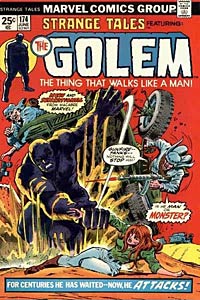 However, through all of this, Chabon wants us to see that we can’t rely on golems any more than we can rely on superheroes. After all, the Jews of Prague don’t activate their golem to fight Hitler. Instead, they send it away in order to protect it. When the box with that same golem mysteriously arrives at Sammy’s home many years after the war, it is nothing but a box of dirt. According to Jewish legend, when it left its homeland, it disintegrated and lost its potency.
However, through all of this, Chabon wants us to see that we can’t rely on golems any more than we can rely on superheroes. After all, the Jews of Prague don’t activate their golem to fight Hitler. Instead, they send it away in order to protect it. When the box with that same golem mysteriously arrives at Sammy’s home many years after the war, it is nothing but a box of dirt. According to Jewish legend, when it left its homeland, it disintegrated and lost its potency.
Chabon’s message is that the modern golem is found in the creation of art. His own piece about golems and novel writing shows this. I ended the class by reading an engaging passage from the book, and I will end this blog in the same way. Here, Joe is thinking about all of the detritus of his life as a comic book artist:
In literature and folklore, the significance and the fascination of golems—from Rabbi Loew’s to Victor von Frankenstein’s—lay in their soullessness, in their tireless inhuman strength, in their metaphorical association with overweening human ambition, and in the frightening ease with which they passed beyond the control of their horrified and admiring creators. But it seemed to Joe that none of these—Faustian hubris, least of all—were among the true reasons that impelled men, time after time, to hazard the making of golems. The shaping of a golem, to him, was a gesture of hope, offered against hope, in a time of desperation. It was the expression of a yearning that a few magic words and an artful hand might produce something—one poor, dumb, powerful thing—exempt from the crushing strictures, from the ills, cruelties, and inevitable failures of the greater Creations. It was the voicing of a vain wish, when you got down to it, to escape. (582).
Automata 101: The Artist as Golem Maker – Part One
Rhonda Knight is an Associate Professor of English at Coker College in Hartsville, SC. She teaches Medieval and Renaissance literature as well as composition courses. This blog will outline her experiences teaching an Honors English Composition course about created entities, beginning with the golem of Jewish legend and continuing through cyborgs, robots, androids, and artificial intelligence.
Note: I’m not sure why I feel the need to announce spoilers here since I have not done so with my previous blogs, but be warned I give away a lot of plot here.
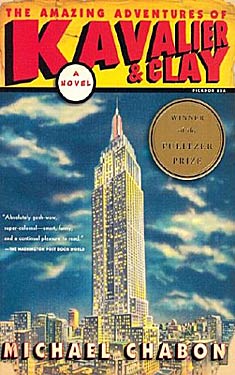 The last book that we read was Michael Chabon’s The Amazing Adventures of Kavalier and Clay. I highly recommend this book. I think it is much more interesting than the Hugo-winning The Yiddish Policeman’s Union, and it has convinced me that I need to read everything that Chabon has written.
The last book that we read was Michael Chabon’s The Amazing Adventures of Kavalier and Clay. I highly recommend this book. I think it is much more interesting than the Hugo-winning The Yiddish Policeman’s Union, and it has convinced me that I need to read everything that Chabon has written.
I put this book last on the syllabus for a couple of reasons. First, it is very long (636 pages), so I wanted to spread the reading out. The students were working on their research papers at the same time, so there were writing and research days interspersed. Second, because the book is recent, I was not sure how much research existed on it, so I placed it late in the semester so that it would not be an obvious choice to be the subject of the research paper. While the students did not like the length of the novel (and had a hard time keeping up with the reading schedule), they did like the book very much. I think that they were appreciative of a non-science fiction book at this point in the semester. One thing that I’ve learned is that habitual readers of speculative fiction grasp an author’s constructed world very quickly and therefore, understand the culture, laws, etc. without much effort. Many of the students, either through age or reading experience, were not facile in their grasp of Dick’s or Piercy’s dystopias. Therefore, Kavalier and Clay gave them a world that they knew something about and operated in much the same way as their own.
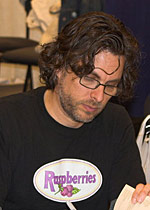 Teacherly confession: I loved Kavalier and Clay when I read it in July, but I had no idea how I was going to teach it or how I was going to tie it into the other texts. I decided I’d figure it out, and luckily I did. I could have never made the book work if I had not taught Piercy’s He, She and It. In Piercy’s novel, Malkah’s interwoven story of Joseph the golem laid the foundation for Chabon’s golem. The students entered the first section with most of the background they needed to understand Josef Kavalier’s escape from Czechoslovakia.
Teacherly confession: I loved Kavalier and Clay when I read it in July, but I had no idea how I was going to teach it or how I was going to tie it into the other texts. I decided I’d figure it out, and luckily I did. I could have never made the book work if I had not taught Piercy’s He, She and It. In Piercy’s novel, Malkah’s interwoven story of Joseph the golem laid the foundation for Chabon’s golem. The students entered the first section with most of the background they needed to understand Josef Kavalier’s escape from Czechoslovakia.
Our discussion opened with a look at the narrative voice. The book is written in the third person, but not in the typical third person omniscient manner. One feels that the narrator is a scholar, historian, biographer or comic book fan, as the book’s first sentences show:
In later years, holding forth to an interviewer or to an audience of aging fans at a comic book convention, Sam Clay liked to declare, apropos of his and Joe Kavalier’s greatest creation, that back when he was a boy, sealed and hog-tied inside the airtight vessel known as Brooklyn, New York, he had been haunted by dreams of Harry Houdini. “To me, Clark Kent in a phone booth and Houdini in a packing crate, they were one and the same thing,” he would learnedly expound at WonderCon or Angloulême or to the editor of The Comics Journal.
In support of this voice, the book contains footnotes (although not to the level of Susanna Clarke’s Jonathan Strange and Mr. Norell) that informs the reader of such things as $42,200 was the selling price of Amazing Midget Radio Comics #1 in 1998 and Roy Lichtenstein might have been inspired by an enlarged comic page framed in Sammy’s office that revealed the lithography dots. I taught the students to look for such textual clues that reveal the humanity of the narrator.
In the second class, I told the students that I wanted to look at the protagonists’ names, Josef Kavalier and Sammy Klayman. We talked about their meanings: Kavalier = Cavalier = Chevalier = Knight; and Klayman = Clay Man = Golem. I admitted to them that I was unsure what to do with those meanings but suggested that we think about how to apply them as we continued to read. We came to the meaning of Joe’s surname quickly. If we took “knight” to mean “knight in shining armor,” then it is easy to apply the cliché and find a hero and a rescuer in Joe. His commitment to his Czech relatives and his actions during WWII are heroic in their own way. In his return after the war, he becomes a superhero, like one of his creations, with a secret lair and a disguise.
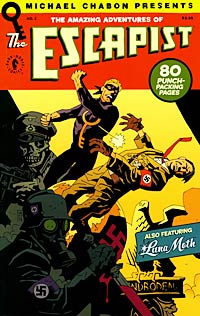 Sammy’s role as the golem was harder to understand. Once we started to think about the golem’s role as a protector of the Jews, we were able to see that Sammy becomes the protector of Joe’s fiancée, Rosa, and her unborn child. Sammy, who was planning on moving to L.A. with his male lover, marries Rosa after Joe runs away and joins the Navy. Instead of protecting the ghetto, Sammy as golem makes a family and moves it to the Long Island suburbs. He suppresses his own sexuality to play the straight family man for Joe. In our discussion of He, She and It, we looked at the callous way that the Rabbi “deactivates” the golem Joseph. We felt that the ambiguity of Kavalier and Clay’s ending indicated Sammy’s deactivation as a golem: his job was done, and he became disposable. I stressed to the students that everything the narrative voice had been telling us about Sammy demonstrated that Sammy had a good life after he left. We decided that his golem, unlike all of the golems we had encountered, received his freedom.
Sammy’s role as the golem was harder to understand. Once we started to think about the golem’s role as a protector of the Jews, we were able to see that Sammy becomes the protector of Joe’s fiancée, Rosa, and her unborn child. Sammy, who was planning on moving to L.A. with his male lover, marries Rosa after Joe runs away and joins the Navy. Instead of protecting the ghetto, Sammy as golem makes a family and moves it to the Long Island suburbs. He suppresses his own sexuality to play the straight family man for Joe. In our discussion of He, She and It, we looked at the callous way that the Rabbi “deactivates” the golem Joseph. We felt that the ambiguity of Kavalier and Clay’s ending indicated Sammy’s deactivation as a golem: his job was done, and he became disposable. I stressed to the students that everything the narrative voice had been telling us about Sammy demonstrated that Sammy had a good life after he left. We decided that his golem, unlike all of the golems we had encountered, received his freedom.
I’ve managed to demonstrate only a portion of our discussion. In my next blog, I will talk more about Chabon’s use of the superhero and its relation to the golem.
Automata 101: Cyborgs and Androids – Part 2
Rhonda Knight is an Associate Professor of English at Coker College in Hartsville, SC. She teaches Medieval and Renaissance literature as well as composition courses. This blog will outline her experiences teaching an Honors English Composition course about created entities, beginning with the golem of Jewish legend and continuing through cyborgs, robots, androids, and artificial intelligence.
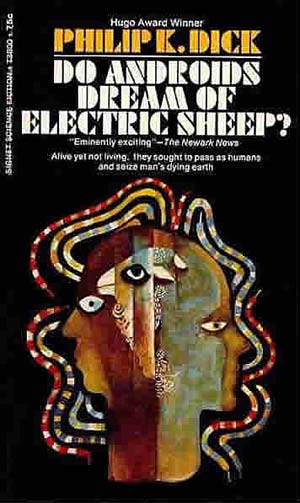 I taught Philip K Dick’s Do Androids Dream of Electric Sheep? and Ridley Scott’s Blade Runner (1982) as a unit. I had not taught a PKD novel before, and I thought that his style would be a challenge for the students. Previously, I had taught some of his short stories (“The Hanging Stranger,” “Exhibit Piece,” “The Chromium Fence,” “We Can Remember It For You Wholesale,” “The Minority Report,” and “Paycheck”) in a science fiction class to mixed results. In that class, the students who were familiar with such shows as The Twilight Zone and The Outer Limits were able to see similarities between them and PKD’s stories. However, most of them did not have the historical understanding of 1950s and 1960s suburbia to grasp his deep satire of that life.
I taught Philip K Dick’s Do Androids Dream of Electric Sheep? and Ridley Scott’s Blade Runner (1982) as a unit. I had not taught a PKD novel before, and I thought that his style would be a challenge for the students. Previously, I had taught some of his short stories (“The Hanging Stranger,” “Exhibit Piece,” “The Chromium Fence,” “We Can Remember It For You Wholesale,” “The Minority Report,” and “Paycheck”) in a science fiction class to mixed results. In that class, the students who were familiar with such shows as The Twilight Zone and The Outer Limits were able to see similarities between them and PKD’s stories. However, most of them did not have the historical understanding of 1950s and 1960s suburbia to grasp his deep satire of that life.
Of course, much of Do Androids deals with the satire of that “Keeping Up with the Joneses” attitude we often connect with the suburban lifestyle. With a little bit of prompting, the students in my current class began to see the materialism of the society in Do Androids and were able to connect it to our culture. We talked about how in the cultural capital of Deckard’s world the status of owning a horse could equate to our status in owning smart phones, designer clothing and expensive cars. We talked about how the title Do Androids Dream of Electric Sheep? has multiple meanings that feed into that American Dream/”Keeping Up with the Joneses” attitude for both the humans and the androids in the text. The humans, represented by Deckard, are dreaming not of electric sheep but real ones. For the androids, owning an electric sheep would be a sign that they were successfully passing as humans. Therefore, they would not care if the sheep were electric or organic. The androids want the lives of the humans, but can they really achieve that type of lifestyle? Would the domestic lives of androids only be simulacra of humanity, minus feeling and empathy?
Given our discussion of the posthuman in He, She and It, much of our discussion centered on the ways that the humans exhibited posthuman qualities through the use of the Penfield mood organs and through the Mercer empathy boxes. 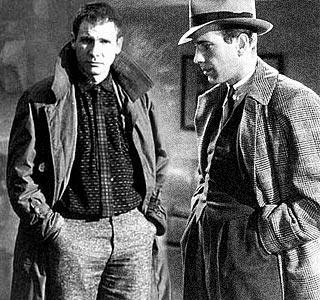 This was not where I planned for the conversation to go that day, so I was especially proud that the students were making connections between the readings and bringing them up. I will confess that none of us really understood Mercerism, but we feel that we all have a greater understanding of empathy. In preparation for teaching this book, I found a very interesting podcast by David Gill that helped me formulate some of my ideas. Later, I found an interview with Gill that was also helpful. One of Gill’s interesting insights in this interview is that “Scott wanted to talk about how great Androids could be. Dick wanted to talk about how crummy humans could be.”
This was not where I planned for the conversation to go that day, so I was especially proud that the students were making connections between the readings and bringing them up. I will confess that none of us really understood Mercerism, but we feel that we all have a greater understanding of empathy. In preparation for teaching this book, I found a very interesting podcast by David Gill that helped me formulate some of my ideas. Later, I found an interview with Gill that was also helpful. One of Gill’s interesting insights in this interview is that “Scott wanted to talk about how great Androids could be. Dick wanted to talk about how crummy humans could be.”
I planned the syllabus so that the students could watch Blade Runner while I was away at the Blackfriars Conference. Because of this, I started out training them to watch PKD as interpreted by Ridley Scott. Once I started teaching I realized that I could have spent a month just doing this. However, in my shorthand version, I tried to introduce the students quickly to hard-boiled detectives and film noir. I explained to them how Blade Runner interprets Do Androids through these two genres. In my opinion, Scott’s Deckard is the descendant of Philip Marlowe and Sam Spade—PKD’s Deckard, not so much. I showed the students the openings (15-30 minutes) of three movies, Laura (1944), Double Indemnity (1944), and L.A. Confidential (1997). I wanted them to see the noir visual characteristics of light and shadow as well as hear the typical hard-boiled, tough guy patter. If I had more time, I would have added The Big Sleep (1946) to really encapsulate the characteristics of the detective. I was able to show the students the first section of Blade Runner before I left for the conference. We were able to compare Scott’s use of smoke, light and shadow with the scenes that we watched in the other movies.
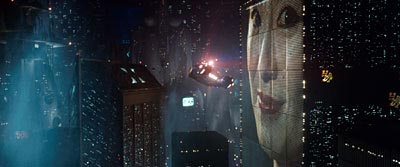 The students finished most of the movie while I was away, and then we watched the ending when I returned. We discussed the ambiguous ending and the different characterizations of Deckard, Rachael, Pris and Roy. The students were very interested in the setting and were somewhat confused by the prevalence of Asian culture. I explained to them that Dick was a northern Californian and that Do Androids is set in San Francisco (they had missed the clues). At that point, someone made the connection to Chinatown, and they decided they liked Scott’s choice once they understood the reasons for it.
The students finished most of the movie while I was away, and then we watched the ending when I returned. We discussed the ambiguous ending and the different characterizations of Deckard, Rachael, Pris and Roy. The students were very interested in the setting and were somewhat confused by the prevalence of Asian culture. I explained to them that Dick was a northern Californian and that Do Androids is set in San Francisco (they had missed the clues). At that point, someone made the connection to Chinatown, and they decided they liked Scott’s choice once they understood the reasons for it.
I learned long ago that when teachers teach texts that they love too much they are bound to get their feelings hurt when the students don’t react the way they wish. I tried to protect myself with Blade Runner and observed some interesting things. First, in the students’ minds Blade Runner, Double Indemnity, and Metropolis are all “old movies.” They always react to the alterity of the movies first before they react to the narratives. They have a hard time either ignoring or embracing the strangeness of the form. Second, they were able to watch the movie without all of the 80s popular culture baggage that I experienced then and still experience now. For example, they have no sense of Darryl Hannah or Rutger Hauer outside that film, while these actors’ later success has always influenced my subsequent viewings of the movie. At one point I mentioned that the movie was released on the tail of Harrison Ford’s success as Han Solo and Indiana Jones. A student said “Oh, that’s who he is. I thought he looked familiar.” All I could do was shrug. In a way, this lack of knowledge gave them a purer viewing experience than I could ever have. Third, the students preferred the movie to the book but were not always able to articulate why. With prodding, they figured out that the sex between Rachael and Deckard was off-putting in the book but not in the movie because in the movie there was a hope that the catalyst was romance not ego or manipulation. 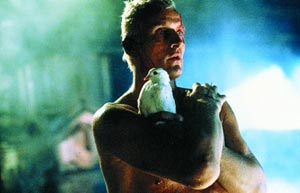 They also liked Deckard better in the movie because he seems stronger. I explained to them that their expectations had been programmed by the hard-boiled detective even though they have never seen a Humphrey Bogart movie and don’t know who he is (really, they don’t). They missed the gadgets in the movie but not Mercerism. They were also surprised that mankind’s relationship with animals was such a footnote in the movie since it was so important in the book.
They also liked Deckard better in the movie because he seems stronger. I explained to them that their expectations had been programmed by the hard-boiled detective even though they have never seen a Humphrey Bogart movie and don’t know who he is (really, they don’t). They missed the gadgets in the movie but not Mercerism. They were also surprised that mankind’s relationship with animals was such a footnote in the movie since it was so important in the book.
All in all, this was a successful section, but it has made me think about PKD even more. I’ve not read many of his novels, only The Man in the High Castle besides Do Androids, but I have been following Charles Dee Mitchell’s blog on this site, and it is helping me decide which books I might want to read (and the ones that I don’t).
Automata 101: Cyborgs and Androids
Rhonda Knight is an Associate Professor of English at Coker College in Hartsville, SC. She teaches Medieval and Renaissance literature as well as composition courses. This blog will outline her experiences teaching an Honors English Composition course about created entities, beginning with the golem of Jewish legend and continuing through cyborgs, robots, androids, and artificial intelligence.
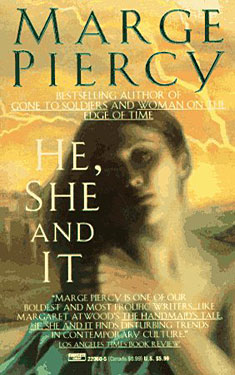 So… it’s been a while. My jet-set life as an English professor has kept me from writing. In October, I attended the Popular Culture/American Culture in the South conference in New Orleans and the Blackfriars Conference at the American Shakespeare Center in Staunton, VA. The Popular Culture conference offered papers on many science fiction and horror television shows, such as Doctor Who, Lost, Torchwood and everything in the Whedonverse, and fantasy and science fiction authors, such as Susanna Clarke, Kurt Vonnegut, Terry Pratchett, Neil Gaiman, Nalo Hopkinson, Michael Chabon, and George R. R. Martin. One of the best papers I heard was on how Fox used trailers to react to the fandom of their Fringe Fridays.
So… it’s been a while. My jet-set life as an English professor has kept me from writing. In October, I attended the Popular Culture/American Culture in the South conference in New Orleans and the Blackfriars Conference at the American Shakespeare Center in Staunton, VA. The Popular Culture conference offered papers on many science fiction and horror television shows, such as Doctor Who, Lost, Torchwood and everything in the Whedonverse, and fantasy and science fiction authors, such as Susanna Clarke, Kurt Vonnegut, Terry Pratchett, Neil Gaiman, Nalo Hopkinson, Michael Chabon, and George R. R. Martin. One of the best papers I heard was on how Fox used trailers to react to the fandom of their Fringe Fridays.
While I was away hearing such papers and giving one on mystery novelist Martha Grimes, my students were reading and writing and thinking about Marge Piercy’s He, She and It. This novel was a good hinge point for the semester because it effectively combines our golem exploration with our robot exploration.
For those of you who don’t know, the book is set in a near post-apocalyptic future in which the world is run by corporate cities, called multis or enclaves, that exist inside protective radiation barriers. The bulk of the novel’s action takes place in one of the few independent towns, Tikva. It is a Jewish enclave of computer programmers who create security programs for the multis. Their skill allows them to leverage freedom. Shira, a disfavored employee of a multi, returns to her hometown of Tikva to help Avram, a cyberneticist, train his illegally-created cyborg, Yod, to appear more human. Yod’s purpose is to protect both the real and virtual borders of the town.
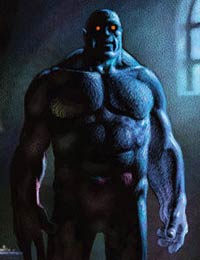 This future narrative is interpolated with a “bedtime story” that Malkah, Shira’s grandmother, tells the cyborg, Yod. This story is about Rabbi Judah Loew and the sixteenth-century golem of Prague and draws parallels between Yod’s role and that of Joseph, the golem in Malkah’s story. I used these parallels as a starting point to discuss the role of Jews in Western history. I explained to the students the ways that medieval Christians created ghettos and forced Jews into the occupations of moneylenders and bankers. We then compared Tikva to a neo-ghetto in which the Jews are allowed to live free in order to provide the dominant culture with specific services. In addition, we compared the super-human traits of Joseph the golem, strength and healing ability, with those of the cyborg. One of the most interesting parallels that Piercy presents is the similar attitudes that the creators, Avram and the Rabbi, hold towards their creations. To them, the golem and the cyborg are tools that can be sacrificed, while the other characters view them as humans.
This future narrative is interpolated with a “bedtime story” that Malkah, Shira’s grandmother, tells the cyborg, Yod. This story is about Rabbi Judah Loew and the sixteenth-century golem of Prague and draws parallels between Yod’s role and that of Joseph, the golem in Malkah’s story. I used these parallels as a starting point to discuss the role of Jews in Western history. I explained to the students the ways that medieval Christians created ghettos and forced Jews into the occupations of moneylenders and bankers. We then compared Tikva to a neo-ghetto in which the Jews are allowed to live free in order to provide the dominant culture with specific services. In addition, we compared the super-human traits of Joseph the golem, strength and healing ability, with those of the cyborg. One of the most interesting parallels that Piercy presents is the similar attitudes that the creators, Avram and the Rabbi, hold towards their creations. To them, the golem and the cyborg are tools that can be sacrificed, while the other characters view them as humans.
Our ability to question the human status of the golem and the cyborg gave us the opportunity to explore the “humanity” of many of the other characters. Now, when I say humanity here, I’m not thinking about the characteristics of being a good person, such as kindness, empathy, etc. Instead, I am thinking about humanity as informed by post-human studies. I recently read a book Cyberculture, Cyborgs and Science Fiction: Consciousness and the Posthuman (2006) by William S. Haney II. This book cited another author Katherine Hayles, who wrote How We Became Posthuman: Virtual Bodies in Cybernetics, Literature and Informatics (1999). Haney uses two passages from Hayles’ book to define the posthuman. 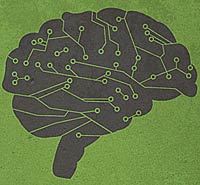 I pulled those two passages to guide our discussion. The first is “the posthuman view thinks of the body as the original prosthesis we all learn to manipulate, so that extending or replacing the body with other prostheses becomes a continuation of a process that began before we were born” (Haney 2). The second is “[i]n the posthuman, there are no essential differences or absolute demarcations between bodily existence and computer simulation, cybernetic mechanism and biological organism, robot teleology and human goals” (Haney 2).
I pulled those two passages to guide our discussion. The first is “the posthuman view thinks of the body as the original prosthesis we all learn to manipulate, so that extending or replacing the body with other prostheses becomes a continuation of a process that began before we were born” (Haney 2). The second is “[i]n the posthuman, there are no essential differences or absolute demarcations between bodily existence and computer simulation, cybernetic mechanism and biological organism, robot teleology and human goals” (Haney 2).
The first passage is particularly relevant to He, She and It because most of the humans are technologically enhanced for cosmetic or occupational reasons. Shira tells Yod: “We’re all unnatural now. I have retinal implants. I have a plug set into my skull to interface with a computer. I read time by corneal implant. Malkah has a subcutaneous unit that monitors and corrects blood pressure and half her teeth are regrown” (Piercy 150). The most interesting character is Nili, who is human but her body is so heavily modified with implants, sensors and lasers that upon meeting her the characters think that she is a cyborg. Her actions and lack of emotion continue to make her seem more robotic than Yod. Serving as a foil for the cyborg, Nili fueled our conversation about what makes one human, biology or actions. The students saw the enhancements that Shira discussed above as very sci-fi. However, I quizzed them about how nose jobs, breast implants, lasik eye surgery, pacemakers, and artificial limbs might relate to the first passage. We referred back to Asimov’s The Bicentennial Man and wondered if humans might one day begin a process that is the reverse of Andrew Martin’s so that we become less and less organic. This, of course, led us to mention the woman who’s had so many plastic surgeries.
 The second passage allowed us to touch on many subjects that are contemporary. In He, She and It the characters work and play through a virtual interface where they appear as avatars and are able to manipulate their environment. The septuagenarian, Malkah, maintains several virtual relationships in which she represents herself as both males and females with various ages and sexual preferences. This led us to all sorts of conversations about online dating, Facebook (especially the social games), Second Life, and other cyberworlds we can enter. We thought about the possibilities of becoming someone else in a cyberworld. These changes of identity are always seen as the moves that a pedophile or stalker uses. We tried to think about more benign reasons for adopting cyber-identities, because society is getting to the point in which one could live a complete cyber-existence by telecommuting and by using online banking, shopping and social networks. Someone brought up Lt. Barclay’s holodeck obsession on Star Trek: The Next Generation as an example of a type of mental illness that could be developing because of our cyber-existences.
The second passage allowed us to touch on many subjects that are contemporary. In He, She and It the characters work and play through a virtual interface where they appear as avatars and are able to manipulate their environment. The septuagenarian, Malkah, maintains several virtual relationships in which she represents herself as both males and females with various ages and sexual preferences. This led us to all sorts of conversations about online dating, Facebook (especially the social games), Second Life, and other cyberworlds we can enter. We thought about the possibilities of becoming someone else in a cyberworld. These changes of identity are always seen as the moves that a pedophile or stalker uses. We tried to think about more benign reasons for adopting cyber-identities, because society is getting to the point in which one could live a complete cyber-existence by telecommuting and by using online banking, shopping and social networks. Someone brought up Lt. Barclay’s holodeck obsession on Star Trek: The Next Generation as an example of a type of mental illness that could be developing because of our cyber-existences.
Like all good literature, Piercy’s book poses several big questions throughout the plot, but those questions relate to her readers and our world as well as the world she created. The students, for the most part, found this book interesting and relatable.
Automata 101: Robots and the Mechanical Age
Rhonda Knight is an Associate Professor of English at Coker College in Hartsville, SC. She teaches Medieval and Renaissance literature as well as composition courses. This blog will outline her experiences teaching an Honors English Composition course about created entities, beginning with the golem of Jewish legend and continuing through cyborgs, robots, androids, and artificial intelligence.
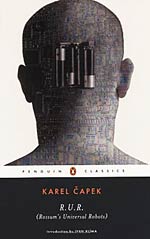 This section focuses on two texts and a film: Karel Capek’s play R.U.R. (Rossum’s Universal Robots), Fritz Lang’s Metropolis, and Isaac Asimov’s collection of short stories and essays Robot Visions. I chose the latter instead of the more popular I, Robot for two reasons. First, the number of stories plus their mixture with essays gave me a great choice of texts. The essays provided the students with some background and analytical exploration of robots. The second reason is the collection contained the novelette The Bicentennial Man, which I wanted to teach to provide a longer example of Asimov’s work. The students were excited to get to robots, the shiny humanoid forms, after the automata of the previous section.
This section focuses on two texts and a film: Karel Capek’s play R.U.R. (Rossum’s Universal Robots), Fritz Lang’s Metropolis, and Isaac Asimov’s collection of short stories and essays Robot Visions. I chose the latter instead of the more popular I, Robot for two reasons. First, the number of stories plus their mixture with essays gave me a great choice of texts. The essays provided the students with some background and analytical exploration of robots. The second reason is the collection contained the novelette The Bicentennial Man, which I wanted to teach to provide a longer example of Asimov’s work. The students were excited to get to robots, the shiny humanoid forms, after the automata of the previous section.
We began with Capek’s play, which gave the world the word “robot,” which is the Czech word for “serf.” Capek’s dystopic play, performed and published in 1921, is very concerned with the rights of the worker. It appeared in a time and a place where communism, socialism and capitalism were beginning to clash. The play enjoyed international success, debuting on Broadway in 1922 and in the West End in 1923. By the time it was performed in London, the play had been translated into thirty languages and performed in many other cities.
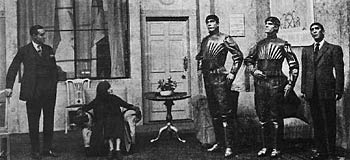 While the students’ expectations of CP3O-like robots were not exactly met, they were not disappointed. They learned that these “original” robots of R.U.R. were not mechanical at all but were instead organic in composition. However, this fact does not matter too much because the mechanical mode of production Capek describes puts one in mind of Henry Ford’s assembly line with robots working to produce more robots ad nauseum. We talked a lot about Capek’s world and why a world freed from work might be appealing, especially when many workers of the time felt as if they were dehumanized and only a part of the machinery of capitalism.
While the students’ expectations of CP3O-like robots were not exactly met, they were not disappointed. They learned that these “original” robots of R.U.R. were not mechanical at all but were instead organic in composition. However, this fact does not matter too much because the mechanical mode of production Capek describes puts one in mind of Henry Ford’s assembly line with robots working to produce more robots ad nauseum. We talked a lot about Capek’s world and why a world freed from work might be appealing, especially when many workers of the time felt as if they were dehumanized and only a part of the machinery of capitalism.
I structured the class so that the students read the Prologue and Act 1 for a Monday, on Wednesday we watched excerpts of Metropolis in class, and then we finished the play on Friday. Showing them Metropolis really helped them visualize how Capek thought about labor. The class is only 50 minutes, so I had to choose sections of the movie carefully. We focused on the first few minutes that juxtapose the workers at shift change with the rich boy Freder in the Eternal Gardens. The second section we watched was the explosion of the M-Machine in the factory, and finally we watched Maria’s transformation into the “machine-man.” Some of these moments are in this restoration trailer. (The students did finally get their shiny robot.)
 We concluded our discussion of R.U.R., focusing on the character of Helena, who through her desire to be a do-gooder, dooms mankind to extinction. Many of them noticed that Helena represented the upper class who wanted to improve the world but did not know the price of a loaf of bread. She has the charm of her namesake, Helen of Troy, and uses it to convince Dr. Gall to give the robots souls. This change created a new race of robots, who suddenly cared that they were working for beings who were weaker and dumber than they were. This caused the worldwide revolt and slaughter of all of humanity, except for one man who could build any more robots because Helena had destroyed the formula as a last-ditch effort to remedy her mistakes.
We concluded our discussion of R.U.R., focusing on the character of Helena, who through her desire to be a do-gooder, dooms mankind to extinction. Many of them noticed that Helena represented the upper class who wanted to improve the world but did not know the price of a loaf of bread. She has the charm of her namesake, Helen of Troy, and uses it to convince Dr. Gall to give the robots souls. This change created a new race of robots, who suddenly cared that they were working for beings who were weaker and dumber than they were. This caused the worldwide revolt and slaughter of all of humanity, except for one man who could build any more robots because Helena had destroyed the formula as a last-ditch effort to remedy her mistakes.
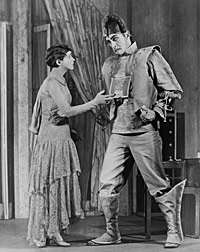 The ending of the play is ambiguous but points toward a super-evolved robot couple, Primus and Helena (named after the character), repopulating the earth the old-fashioned way. The Robot Helena is a commentary on her namesake. Dr. Gall remarks: “She is as lovely and foolish as the spring. Simply good for nothing.” Unlike the sterile human Helena, she developed the ability to procreate and with Primus (whose name means “first”) becomes, the new Adam and Eve.
The ending of the play is ambiguous but points toward a super-evolved robot couple, Primus and Helena (named after the character), repopulating the earth the old-fashioned way. The Robot Helena is a commentary on her namesake. Dr. Gall remarks: “She is as lovely and foolish as the spring. Simply good for nothing.” Unlike the sterile human Helena, she developed the ability to procreate and with Primus (whose name means “first”) becomes, the new Adam and Eve.
We noticed that Capek, like Mary Shelley, was not interested in the science of robot creation; Isaac Asimov, however, adds the concept of the positron brain and his three laws to bring in some science. I tried to choose stories that demonstrated Asimov’s exploration of his robots’ humanity, such as “Robbie,” “Evidence,” and “Robot Vision.” (Personally, I prefer the puzzle stories that demonstrate robots acting strangely because the laws are in conflict or a human gives a confusing order, such as “Runaround” or “Little Lost Robot.”) 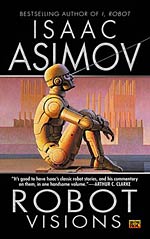 We also read essays in which Asimov explored why humanity would make robots in a human shape (“The Friends We Make”) and what mankind would do if robots replaced it as workers (“Whatever You Wish”). The second one provided an interesting counterpoint to R.U.R.
We also read essays in which Asimov explored why humanity would make robots in a human shape (“The Friends We Make”) and what mankind would do if robots replaced it as workers (“Whatever You Wish”). The second one provided an interesting counterpoint to R.U.R.
The students wrote papers that connected the ideas emerging in this section back to earlier ones. Some explored two reasons that humans fear robots in Asimov’s stories and Capek’s play. Others tried to define Asimov’s term “Frankenstein Complex,” which he never really defines, and to investigate its implications. I asked them to argue if Asimov’s use of the term seems to perpetuate or combat the Frankenstein Complex. Only one student chose the creative option to write a dialog between Capek and Asimov discussing robots, humans and work. All of these themes will transition us nicely to the next section which contains Marge Piercy’s He, She and It and Philip K. Dick’s Do Androids Dream of Electric Sheep?
Automata 101: Gothic Romance and the Uncanny
Rhonda Knight is an Associate Professor of English at Coker College in Hartsville, SC. She teaches Medieval and Renaissance literature as well as composition courses. This blog will outline her experiences teaching an Honors English Composition course about created entities, beginning with the golem of Jewish legend and continuing through cyborgs, robots, androids, and artificial intelligence.
My goal for this section was to introduce the students to the concept of the uncanny and connect it to humanity’s perception of robots. I also wanted to focus on different types of texts in this section. We read short stories, articles, and essays.
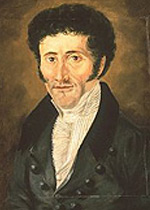 We began by reading the classic “uncanny” short story: E. T. A. Hoffmann’s “The Sandman,” in which a university student, Nathanael, falls in love with an automaton, Olimpia, that he believes is his professor’s daughter. Sigmund Freud used this story in his famous essay on the uncanny to explain the concept. However, we did not read Freud’s essay because it focuses more on castration anxiety than the uncanny. Instead, we read an older essay on the uncanny by Ernst Jentsch, “On the Psychology of the Uncanny (PDF),” published in 1906. This essay posits that our feelings of the uncanny stem from our inability to determine if a figure is alive or not, which is a good, basic concept for us to use in the class.
We began by reading the classic “uncanny” short story: E. T. A. Hoffmann’s “The Sandman,” in which a university student, Nathanael, falls in love with an automaton, Olimpia, that he believes is his professor’s daughter. Sigmund Freud used this story in his famous essay on the uncanny to explain the concept. However, we did not read Freud’s essay because it focuses more on castration anxiety than the uncanny. Instead, we read an older essay on the uncanny by Ernst Jentsch, “On the Psychology of the Uncanny (PDF),” published in 1906. This essay posits that our feelings of the uncanny stem from our inability to determine if a figure is alive or not, which is a good, basic concept for us to use in the class.
While the reading audience sees this live/not live confusion through the character of Nathanael, another Hoffmann story “The Automata” does a better job in conveying the feeling of the uncanny for everyone. When speaking of the fortune-telling automaton, The Turk, that’s all the rage, one character confesses:
“All figures of this sort,” said Lewis, “which can scarcely be said to counterfeit humanity so much as to travesty it in mere images of living death or inanimate life are most distasteful to me. When I was a little boy, I ran away crying from a waxwork exhibition I was taken to, and even to this day I never can enter a place of the sort without a horrible, eerie, shuddery feeling.
When I see the staring, lifeless, glassy eyes of all the potentates, celebrated heroes, thieves, murderers, and so on, fixed upon me, I feel disposed to cry with Macbeth: ‘Thou hast no speculation in those eyes / Which thou dost glare.’ And I feel certain that most people experience the same feeling, though perhaps not to the same extent. For you may notice that scarcely anyone talks, except in a whisper, in waxwork museums. You hardly ever hear a loud word. But it is not reverence for the Crowned Heads and other great people that produces this universal pianissimo; it is the oppressive sense of being in the presence of something unnatural and gruesome; and what I detest most of all is the mechanical imitation of human motions.”
I wanted to counter these Hoffmann stories with an activity that allowed the students to experience a bit of the uncanny rather than search for it in Hoffmann’s dense, gothic prose. I gave them the assignment to watch several videos of robots and write a response that explained why they found a certain one the most uncanny. I sent them to this Creepiest Robots web page at the Huffington Post. (I had them watch the videos numbered 1, 17, 22, and 23, although plenty of them are uncanny.)
While each one of the four robots had one student choose it as the most uncanny, numbers 1 and 17 were the robots that the students wrote about the most. The class discussion was lively as each student defended his or her choice and asked the other students questions about theirs.
Now that the students had a better grasp of the uncanny, we read “The Uncanny Valley” (1970) by roboticist Masahiro Mori. He argues that robots, androids, and cyborgs that are too human-like in appearance fall into an uncanny valley in human perception. He recommends that the creators of these machines avoid making them resemble people too much. You can see his famous graph that depicts the uncanny valley and an interesting slideshow at this blog.
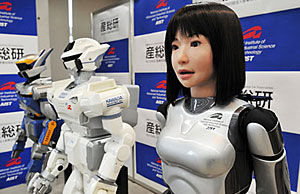 We followed “The Uncanny Valley” with an article from The New Scientist, “What Puts the Creepy into Robot Crawlies? (PDF)” (2007), by Jim Giles. This article is valuable because it summarizes Mori’s argument and then presents newer research. It explains that researchers, Thierry Chaminade and Ayse Saygin of University College London, use brain scans to observe the parts of subjects’ brains that are activated when they see a human, a humanoid robot, and a mechanical robot performing similar human actions, such as picking up a cup. The researchers believe the feeling of the uncanny can be found in the specific areas of the subjects’ brains that are activated only when the humanoid robot is observed.
We followed “The Uncanny Valley” with an article from The New Scientist, “What Puts the Creepy into Robot Crawlies? (PDF)” (2007), by Jim Giles. This article is valuable because it summarizes Mori’s argument and then presents newer research. It explains that researchers, Thierry Chaminade and Ayse Saygin of University College London, use brain scans to observe the parts of subjects’ brains that are activated when they see a human, a humanoid robot, and a mechanical robot performing similar human actions, such as picking up a cup. The researchers believe the feeling of the uncanny can be found in the specific areas of the subjects’ brains that are activated only when the humanoid robot is observed.
The last texts in this section make an interesting pair: Edgar Allan Poe’s 1836 essay, “Maelzel’s Chess Player” and F. Gwynplaine MacIntyre’s story, “The Clockwork Horror,” that fictionalizes Poe’s essay. In “Maelzel’s Chess Player,” Poe, as a writer for Richmond’s Southern Literary Messenger, investigates a traveling automaton show, featuring the Turk, which played chess in exhibition matches. His essay debunks the Turk and explains how a human is hidden in the elaborate box that houses the false automaton. My purpose in assigning this essay was to expose the students to the idea that robot-like automata were not uncommon exhibitions at the time that Hoffmann and his contemporaries were writing about them in fiction.
In fact, the automaton that Poe saw in 1836 was probably Hoffmann’s inspiration for his Turkish fortune-teller. The same machine had been touring Europe and America since the late 1700s. Jane Irwin has created a fabulous web comic about the history of the Turk, Clockwork Game: The Illustrious Career of a Chess-Playing Automaton. I’ve just started reading it. Too bad I didn’t know about the comic when I was teaching this section. I’ve put it on the course website.
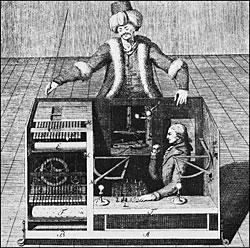 Poe’s essay tells his readers that he commandeers the audience after the Turk’s game and explains how the box contains a hidden chess player and uses magician’s tricks to hide the player during Maezel’s lengthy exposure of the cabinet. Here we glimpse the writer who will create C. Auguste Dupin and his stories of ratiocination. Since Poe’s prose is dense and a bit hard to get through, I also assigned MacIntyre’s story to give the students an account of Poe’s reasoning in a more accessible form. MacIntyre did some research for this horror story and was able to fill in some blanks that Poe left out.
Poe’s essay tells his readers that he commandeers the audience after the Turk’s game and explains how the box contains a hidden chess player and uses magician’s tricks to hide the player during Maezel’s lengthy exposure of the cabinet. Here we glimpse the writer who will create C. Auguste Dupin and his stories of ratiocination. Since Poe’s prose is dense and a bit hard to get through, I also assigned MacIntyre’s story to give the students an account of Poe’s reasoning in a more accessible form. MacIntyre did some research for this horror story and was able to fill in some blanks that Poe left out.
I’m happy with the way this section turned out. The students read several different types of texts–from difficult nineteenth-century authors to an article from a popular science magazine–examined the uncanny from different perspectives, and gained some historical context. They’ll get more history in the next section when we begin with early-twentieth-century robots in R. U. R. and Metropolis.
Automata 101: Frankenstein’s Monster as Golem
Rhonda Knight is an Associate Professor of English at Coker College in Hartsville, SC. She teaches Medieval and Renaissance literature as well as composition courses. This blog will outline her experiences teaching an Honors English Composition course about created entities, beginning with the golem of Jewish legend and continuing through cyborgs, robots, androids, and artificial intelligence.
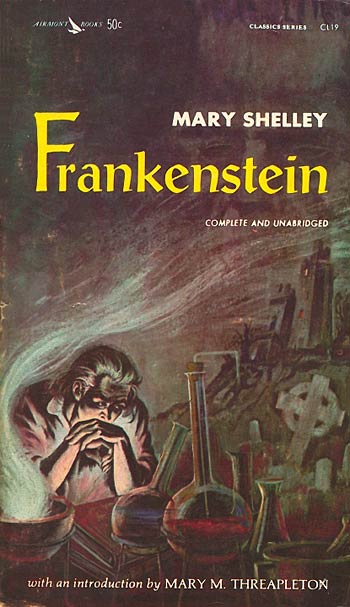 Before we started reading Frankenstein, I wanted to introduce the students to many of the concepts we would work with this semester. For the first class, they listened to a children’s story, The Golem of Prague, and read a different account of it by Jacob Grimm. They also read Jorges Luis Borges’ poem “The Golem” and Biblical and Talmudic verses about the creation. Here’s a translation of Borges’ poem, though we used a different translation from Borges: Selected Poems in class.
Before we started reading Frankenstein, I wanted to introduce the students to many of the concepts we would work with this semester. For the first class, they listened to a children’s story, The Golem of Prague, and read a different account of it by Jacob Grimm. They also read Jorges Luis Borges’ poem “The Golem” and Biblical and Talmudic verses about the creation. Here’s a translation of Borges’ poem, though we used a different translation from Borges: Selected Poems in class.
These varied texts enabled us to list some parameters for the semester’s discussion on the board. The ones that I remember most clearly are:
- creation – magical, divine, scientific: where do they overlap? how can we tell?
- man playing God, creating the other, creating new Adams: what is the responsibility of the maker?
- importance of material in creation: clay, mud, dust, dirt. What other materials will we see?
- communication: why can some golems speak, others not? how will communication or lack of it figure in these texts?
We spent a lot of time working on the complex meaning of Borges’ last stanza:
“In that hour of dread and blurred light,
his eyes lingered on his Golem.
Who will tell us, what did God feel,
looking upon His rabbi in Prague?”
The class focused quickly on the lines’ various interpretations: Does God feel that He failed when He created man? Has He always felt this way? Did the rabbi’s making the Golem cause this feeling? Does this poem pose creation as positive and human or instead ambition as negative and taboo?
 All of this was a perfect set-up for Frankenstein, which we began the next class. Only about four of the seventeen students had read the book before, so much of our first discussion dealt with their surprise that the creature is not called Frankenstein and he’s not a green giant with bolts in his neck. I told the students that that particular image emerged from James Whale’s 1931 movie that starred Boris Karloff as the creature; however I did not know much more. After class, I found a great website that discusses Universal’s make-up artist, Jack Pierce’s, philosophy in designing the monster’s overall look. I posted the link on the course website, and we discussed it a bit in the next class.
All of this was a perfect set-up for Frankenstein, which we began the next class. Only about four of the seventeen students had read the book before, so much of our first discussion dealt with their surprise that the creature is not called Frankenstein and he’s not a green giant with bolts in his neck. I told the students that that particular image emerged from James Whale’s 1931 movie that starred Boris Karloff as the creature; however I did not know much more. After class, I found a great website that discusses Universal’s make-up artist, Jack Pierce’s, philosophy in designing the monster’s overall look. I posted the link on the course website, and we discussed it a bit in the next class.
The students were also surprised that there’s so little discussion of how Victor Frankenstein made the creature. We discussed how this is often considered the first science fiction novel even though it contains very little science. (The WWEnd forum has a good discussion about early science fiction.) We spent some time differentiating the kinds of science that does appear in the book. Interestingly, Shelley’s introduction provides some details of her vision concerning Frankenstein’s use of engines and galvanism in the animation of the creature. Those details are glossed over in the novel. Nevertheless, Shelley very carefully poses the new Enlightenment sciences of chemistry and anatomy against medieval and Renaissance notions of alchemy. Of course, the irony is that the combination of both types of knowledge allows Frankenstein to do the unthinkable and create life.
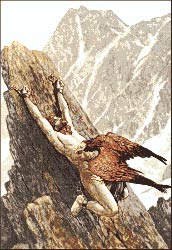 We decided that Shelley’s paucity of science indicates that she’s not really interested in the “how” but in what happens after the creation. I focused them on the novel’s subtitle, The Modern Prometheus, as a way to discuss the book’s role as a cautionary tale against scientific overreaching. Most of them knew that Prometheus brought fire to man in Greek mythology. However, they did not know that in some myths he created mankind from clay and water; this, of course, brought us back to the golem stories. Some remembered that Prometheus’ punishment was to have his internal organs eaten by vultures each day and then they would regenerate at night so that they could be eaten again in an eternal cycle of punishment. We compared this physical punishment to Victor Frankenstein’s mental anguish. I was proud that several of them made the connection between Frankenstein and his interlocutor, Captain Walton, as men whose scientific curiosity could lead to their anguish and destruction.
We decided that Shelley’s paucity of science indicates that she’s not really interested in the “how” but in what happens after the creation. I focused them on the novel’s subtitle, The Modern Prometheus, as a way to discuss the book’s role as a cautionary tale against scientific overreaching. Most of them knew that Prometheus brought fire to man in Greek mythology. However, they did not know that in some myths he created mankind from clay and water; this, of course, brought us back to the golem stories. Some remembered that Prometheus’ punishment was to have his internal organs eaten by vultures each day and then they would regenerate at night so that they could be eaten again in an eternal cycle of punishment. We compared this physical punishment to Victor Frankenstein’s mental anguish. I was proud that several of them made the connection between Frankenstein and his interlocutor, Captain Walton, as men whose scientific curiosity could lead to their anguish and destruction.
The paragraphs above represent only a fraction of issues that arose in class: we also discussed the Edenic/pastoral overtones of the creature’s desires, the role of the Industrial Revolution in Shelley’s work, and Frankenstein as a romantic hero.
I think Frankenstein was a good place to begin our discussion. The novel makes a good foundation for future discussions about the role of responsibility in scientific discovery. The students seemed very grounded in their understanding of the issues we will be exploring. I’m glad they gained that confidence because next up is E.T.A. Hoffman, who is always a bit disjointed and perplexing.
@WWEnd I wonder, will Dr. Knight get to Marge Piercy's He, She & It (Body of Glass) in this course? I hope so…
— Margo-Lea Hurwicz (@MangoHeroics) June 13, 2013
Automata 101: Introduction
Rhonda Knight is an Associate Professor of English at Coker College in Hartsville, SC. She teaches Medieval and Renaissance literature as well as composition courses. This blog will outline her experiences teaching an Honors English Composition course about created entities, beginning with the golem of Jewish legend and continuing through cyborgs, robots, androids, and artificial intelligence.
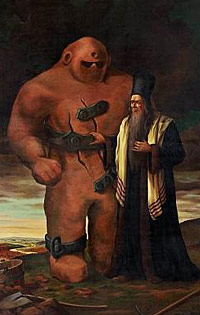 This semester I’m teaching a course that examines the relationship between humans and created beings. (I wish I had a catchier name, but "created beings" seems to cover the various organic, mechanical and digital creatures that inhabit my syllabus.) Since the Worlds Without End site, especially the sub-genre lists, was instrumental in my syllabus development, I decided to share my reading list in the forum. From there, Dave, Rico and I decided that it might be interesting if I blogged about my experiences and those of my students. This first blog will serve as an overview while the subsequent ones will focus on specific texts or issues.
This semester I’m teaching a course that examines the relationship between humans and created beings. (I wish I had a catchier name, but "created beings" seems to cover the various organic, mechanical and digital creatures that inhabit my syllabus.) Since the Worlds Without End site, especially the sub-genre lists, was instrumental in my syllabus development, I decided to share my reading list in the forum. From there, Dave, Rico and I decided that it might be interesting if I blogged about my experiences and those of my students. This first blog will serve as an overview while the subsequent ones will focus on specific texts or issues.
First, a bit about the class: Coker College offers one section of Honors Composition each semester. The students are all good readers and writers as well as enthusiastic and industrious — a pleasure to teach. Most of them are first-semester, first-year students. Often it is a challenge to find literary texts that these students have not studied in their AP or Honors English classes or read on their own, so I always try to pick out-of-the-mainstream texts that most of them have not read or often have not heard about.
This year my inspiration for the course is the keynote speaker for the Coker College Undergraduate Humanities Conference in February. He is J. Andrew Brown, author of Cyborgs in Latin America. (You can download a free copy of the book here.) The conference co-founder, Dr. Mac Williams, is an Assistant Professor of Spanish, and he informed me that there are many innovative Hispanophone novels that explore the relationships between technology and humanity, posthumanity, and the like. I decided that this would be a great way to tie my recreational reading with a class whose goal would be to have student papers worthy for presentation at the conference in February. This type of presentation will be a new experience for freshman students who usually don’t have such opportunities.
In the class, we will read novels, short stories, essays, and articles from social science journals and popular magazines. We will also watch movies. I will talk about the secondary works as I blog about each section, but in this overview it is my intention to discuss each section and the primary works in it.
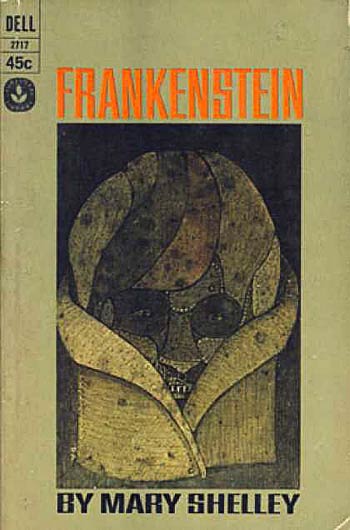 In Frankenstein’s Monster as Golem, we will apply several texts about the Golem and creation to Mary Shelley‘s Frankenstein. The primary questions we will explore in this section are: Why does Victor Frankenstein try to create a being? What is his responsibility to the being once created? What is at stake when one pushes the boundaries of science and knowledge? Can scientists/inventors ever "get it right" if they are afraid to "get it wrong"?
In Frankenstein’s Monster as Golem, we will apply several texts about the Golem and creation to Mary Shelley‘s Frankenstein. The primary questions we will explore in this section are: Why does Victor Frankenstein try to create a being? What is his responsibility to the being once created? What is at stake when one pushes the boundaries of science and knowledge? Can scientists/inventors ever "get it right" if they are afraid to "get it wrong"?
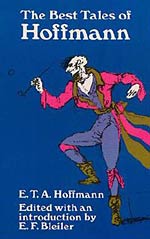 In Gothic Romance and the Uncanny, we will read several short texts — E. T. A. Hoffmann‘s stories, "The Sandman" and "The Automata," Edgar Allan Poe‘s essay, "Maelzel’s Chess Player," and F. Gwynplaine MacIntyre‘s "The Clockwork Horror," which is a retelling of Poe’s essay. My goal in this section is to introduce the students to the concept of the uncanny. The texts all focus on 19th century "robots," or clockwork beings, which will allow us to test the boundaries of what makes these machines uncanny.
In Gothic Romance and the Uncanny, we will read several short texts — E. T. A. Hoffmann‘s stories, "The Sandman" and "The Automata," Edgar Allan Poe‘s essay, "Maelzel’s Chess Player," and F. Gwynplaine MacIntyre‘s "The Clockwork Horror," which is a retelling of Poe’s essay. My goal in this section is to introduce the students to the concept of the uncanny. The texts all focus on 19th century "robots," or clockwork beings, which will allow us to test the boundaries of what makes these machines uncanny.
 In Robots and the Mechanical Age, we will read several of Isaac Asimov‘s stories and essays from Robot Visions and Karel Capek‘s play R. U. R. (Rossum’s Universal Robots). We will also watch clips from Fritz Lang’s Metropolis. I hope that the movie will help the students understand the context of R.U.R, which is a very powerful piece but a bit didactic in its tone. This section explores what happens when mechanical creatures learn, evolve and start making decisions. We will not ignore the Marxist overtones, but we will also look at these robots as robots and not just as symbols the proletariat. We will examine the texts as explorations of human fears and desires concerning robots.
In Robots and the Mechanical Age, we will read several of Isaac Asimov‘s stories and essays from Robot Visions and Karel Capek‘s play R. U. R. (Rossum’s Universal Robots). We will also watch clips from Fritz Lang’s Metropolis. I hope that the movie will help the students understand the context of R.U.R, which is a very powerful piece but a bit didactic in its tone. This section explores what happens when mechanical creatures learn, evolve and start making decisions. We will not ignore the Marxist overtones, but we will also look at these robots as robots and not just as symbols the proletariat. We will examine the texts as explorations of human fears and desires concerning robots.
 In Cyborgs and Androids, we will focus on the two most intriguing novels of the bunch, Marge Piercy‘s He, She and It and Philip K. Dick‘s Do Androids Dream of Electric Sheep? We will also watch Blade Runner. Unfortunately, this is the section that I have thought the least about. I know we will do some work on defining terms, robot, cyborg, and android and discuss their slipperiness in science fiction writing. We will also continue our discussion that we begun in the previous section about created beings and free will.
In Cyborgs and Androids, we will focus on the two most intriguing novels of the bunch, Marge Piercy‘s He, She and It and Philip K. Dick‘s Do Androids Dream of Electric Sheep? We will also watch Blade Runner. Unfortunately, this is the section that I have thought the least about. I know we will do some work on defining terms, robot, cyborg, and android and discuss their slipperiness in science fiction writing. We will also continue our discussion that we begun in the previous section about created beings and free will.
 In the final section, The Artist as Golem Maker, we will read Michael Chabon‘s The Amazing Adventures of Kavalier & Clay. The Golem plays a small role in this novel, but this exploration of the origin of comics provides an interesting way into discussing modern and postmodern ideas of creation. I hope that by November many of the ideas we’ve discussed will represent themselves in the guise of the superheroes.
In the final section, The Artist as Golem Maker, we will read Michael Chabon‘s The Amazing Adventures of Kavalier & Clay. The Golem plays a small role in this novel, but this exploration of the origin of comics provides an interesting way into discussing modern and postmodern ideas of creation. I hope that by November many of the ideas we’ve discussed will represent themselves in the guise of the superheroes.
I hope this introduction has piqued your interest and you will send me feedback as I document the course. So far the students have been extremely enthusiastic and we’ve had some great discussions – more on that in my next blog.



















 Full Details
Full Details

